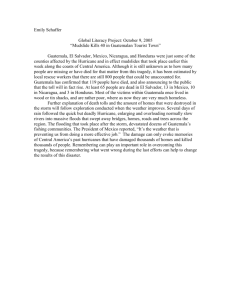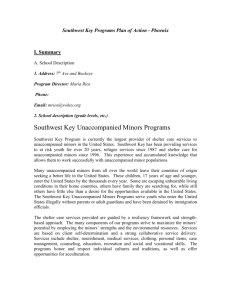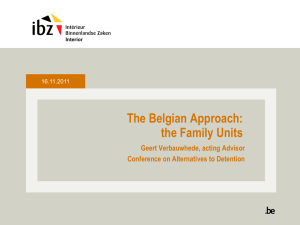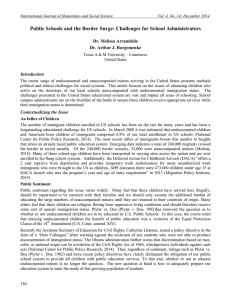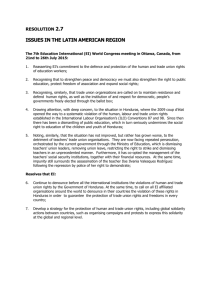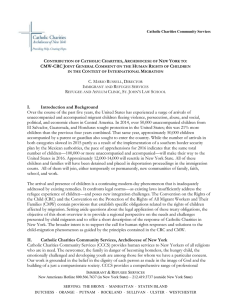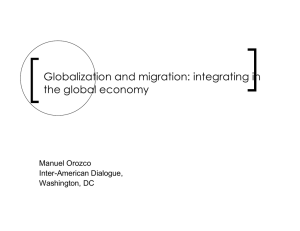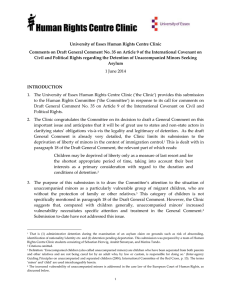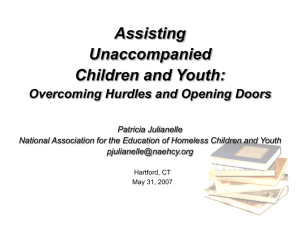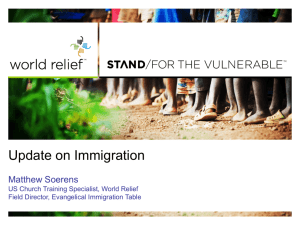Statement for the Record
advertisement
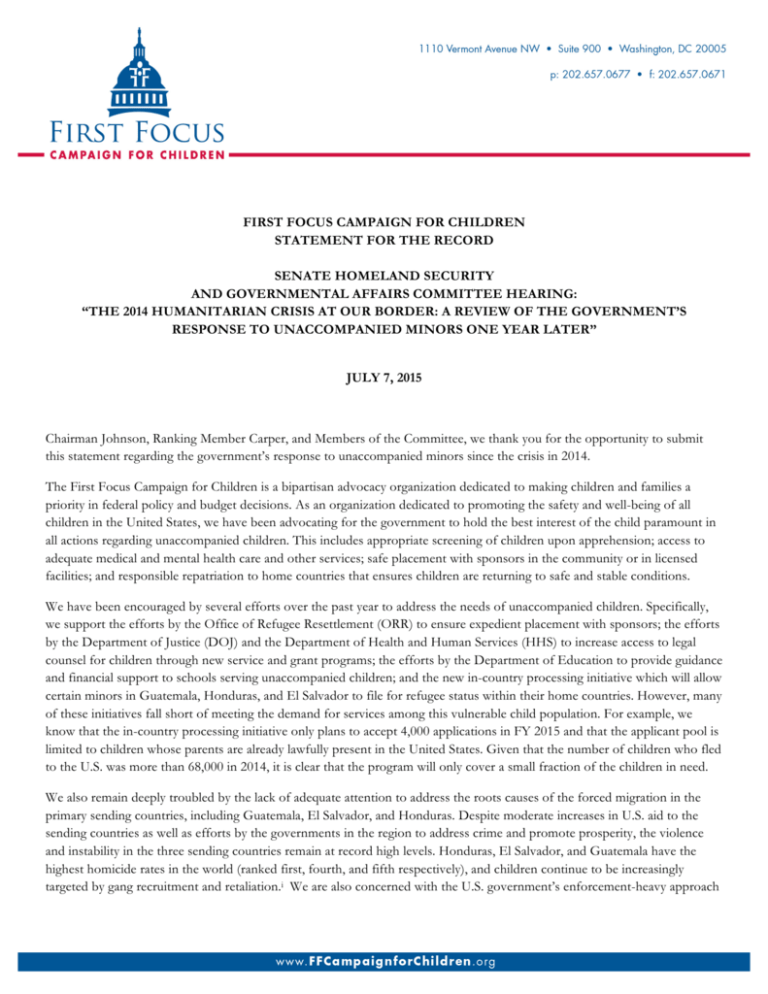
FIRST FOCUS CAMPAIGN FOR CHILDREN STATEMENT FOR THE RECORD SENATE HOMELAND SECURITY AND GOVERNMENTAL AFFAIRS COMMITTEE HEARING: “THE 2014 HUMANITARIAN CRISIS AT OUR BORDER: A REVIEW OF THE GOVERNMENT’S RESPONSE TO UNACCOMPANIED MINORS ONE YEAR LATER” JULY 7, 2015 Chairman Johnson, Ranking Member Carper, and Members of the Committee, we thank you for the opportunity to submit this statement regarding the government’s response to unaccompanied minors since the crisis in 2014. The First Focus Campaign for Children is a bipartisan advocacy organization dedicated to making children and families a priority in federal policy and budget decisions. As an organization dedicated to promoting the safety and well-being of all children in the United States, we have been advocating for the government to hold the best interest of the child paramount in all actions regarding unaccompanied children. This includes appropriate screening of children upon apprehension; access to adequate medical and mental health care and other services; safe placement with sponsors in the community or in licensed facilities; and responsible repatriation to home countries that ensures children are returning to safe and stable conditions. We have been encouraged by several efforts over the past year to address the needs of unaccompanied children. Specifically, we support the efforts by the Office of Refugee Resettlement (ORR) to ensure expedient placement with sponsors; the efforts by the Department of Justice (DOJ) and the Department of Health and Human Services (HHS) to increase access to legal counsel for children through new service and grant programs; the efforts by the Department of Education to provide guidance and financial support to schools serving unaccompanied children; and the new in-country processing initiative which will allow certain minors in Guatemala, Honduras, and El Salvador to file for refugee status within their home countries. However, many of these initiatives fall short of meeting the demand for services among this vulnerable child population. For example, we know that the in-country processing initiative only plans to accept 4,000 applications in FY 2015 and that the applicant pool is limited to children whose parents are already lawfully present in the United States. Given that the number of children who fled to the U.S. was more than 68,000 in 2014, it is clear that the program will only cover a small fraction of the children in need. We also remain deeply troubled by the lack of adequate attention to address the roots causes of the forced migration in the primary sending countries, including Guatemala, El Salvador, and Honduras. Despite moderate increases in U.S. aid to the sending countries as well as efforts by the governments in the region to address crime and promote prosperity, the violence and instability in the three sending countries remain at record high levels. Honduras, El Salvador, and Guatemala have the highest homicide rates in the world (ranked first, fourth, and fifth respectively), and children continue to be increasingly targeted by gang recruitment and retaliation.i We are also concerned with the U.S. government’s enforcement-heavy approach FIRST FOCUS CAMPAIGN FOR CHILDREN STATEMENT FOR THE RECORD SENATE HOMELAND SECURITY AND GOVERNMENTAL AFFAIRS COMMITTEE HEARING ON THE 2014 HUMANITARIAN CRISIS: A REVIEW OF THE GOVERNMENT’S RESPONSE ONE YEAR LATER JULY 7, 2015 to curb the flow of children and families entering the United States and to speed up the removal process. Despite moderate efforts to help children connect to legal counsel, the Administration has increasingly pushed children through “rocket docket” hearings that leave children with very limited time to prepare their cases. Over the past year we have also seen the disturbing massive expansion of family detention, a practice that was largely ended in 2009 due to the government’s own recognition that the practice is inappropriate for children. The government is now holding mothers and children in three family detention centers throughout the country, including the largest family detention center in U.S. history in Dilley, Texas. Administration officials have repeatedly stated that asylum-seeking families are being detained in order to deter other families from making the journey to the U.S. These facilities are ill-equipped to deal with the special needs of traumatized women and children, and research consistently shows that family detention threatens children’s health and development and limits critical access to legal counsel. Finally, while increased enforcement in the region and the Mexico-Guatemala border have been successful in intercepting children en route to the U.S., it is important to note that children are frequently being returned without proper screening. This means that children with valid credible fear claims are being returned to potentially life-threatening situations. Just last week it was reported that a 14-year-old boy named Gredys Alexander Hernández was gunned down in his home in Honduras in the middle of the night.ii Two armed men broke down his family’s door and shot him twice in the head. Gredys’ family told reporters that he had just been deported from the Mexican border two days prior, and after receiving several threats upon being returned to his home he was planning on attempting to make the trek again in two days. His parents also commented that Gredys was a “good boy” who avoided gang activity, and they did not understand why he had been targeted. Unfortunately, Gredys, and so many other kids like him, are not here today to share their story. Gredys can no longer tell us about the constant state of fear he was forced to live in and the daily threats that ultimately drove him to make the long, dangerous trek across three countries to the United States. Gredys is one of the children that officials have “succeeded” in preventing from making it to safety. He’s also one of the many children that have slipped through the cracks of poor asylum screening along the southern Mexican border. And if our government’s enforcement-heavy strategy remains as it is now, coupled with the continued high rate of violence and instability in the region, then we can expect more tragic stories of children like Gredys losing their lives in a crisis that is far from over. As Congress looks back on the efforts that have been made to address the humanitarian crisis over the past year, it critical that questions are asked about what goals have truly been achieved. Are children and families any safer now than they were a year ago? Have we succeeded in ensuring that the best interest of every child is being met? Until we are able to answer these questions affirmatively, then there is still much work that needs to be done. The solution to this humanitarian crisis is not to just make the problem go away. The solution is to work with governments in the region to not just stem the flow but to address the complex root causes of the migration and to treat child and family refugees with the full range of protections they deserve. Anything short of that will continue to put thousands of children’s lives at risk. We thank you again for the opportunity to submit this statement for the record. Should there be any questions regarding this statement, please contact Wendy Cervantes, Vice President of Immigration and Child Rights, at wendyc@firstfocus.org. United Nations Office on Drugs and Crime (UNODC). The Global Study on Homicide. www.unodc.org/gsh/en/data.html El Heraldo. “Hombres encapuchadas asesinan a un menor de edad.” http://www.elheraldo.hn/sucesos/854184-219/hombresencapuchados-asesinan-a-un-menor-de-edad i ii 2
